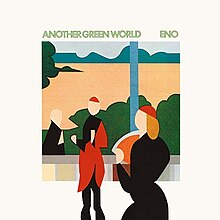Another Green World
| Another Green World | ||||
|---|---|---|---|---|
 |
||||
| Studio album by Eno | ||||
| Released | September 1975 | |||
| Recorded | July–August 1975 | |||
| Studio | Island Studios in London, England | |||
| Genre | ||||
| Length | 40:24 | |||
| Label | Island | |||
| Producer |
|
|||
| Eno chronology | ||||
|
||||
| Professional ratings | |
|---|---|
| Retrospective reviews | |
| Review scores | |
| Source | Rating |
| AllMusic | |
| Blender | |
| Christgau's Record Guide | A+ |
| Entertainment Weekly | A |
| Mojo | |
| MusicHound | 4.5/5 |
| Pitchfork | 10/10 |
| The Rolling Stone Album Guide | |
| Spin Alternative Record Guide | 10/10 |
| Uncut | |
Another Green World is the third studio album by English musician Brian Eno, released by Island Records in September 1975. Produced by Eno and Rhett Davies, it featured contributions from several guest musicians including Robert Fripp, Phil Collins, and John Cale. The album marked a transition from the rock-based music of Eno's previous releases toward the minimalist sensibility of his late '70s ambient work. Employing tactics derived from his Oblique Strategies cards for guidance, the album utilized a variety of unconventional recording techniques and instrumental approaches, and made use of fewer lyrics.
Though the album failed to chart in the United States or the United Kingdom, Another Green World was initially met with high praise from critics. Contemporary reception of Another Green World has been very positive; several critics and publications have placed the album on lists of the top albums of all time.
Another Green World was recorded at Island Studios in London during the months of July and August 1975. Brian Eno originally viewed his new album as an experiment and entered the recording studio with nothing written or prepared beforehand. For the first four days in the studio, Eno failed to be productive. To look for new ideas, Eno turned to his instructional cards, the Oblique Strategies, and began coming up with new ideas as he did with his previous album Taking Tiger Mountain (By Strategy).
Some of the album credits for the instruments have fanciful names that describe the sound they make. The "Castanet Guitars" are electric guitars played with mallets and are electronically treated to sound something like castanets. The "Leslie piano" is an acoustic piano miked and fed through a Leslie speaker with a built-in revolving horn speaker. Eno described the "snake guitar" and "digital guitar" by stating "the kind of lines I was playing reminded me of the way a snake moves through the brush, a sort of speedy, forceful, liquid quality. Digital guitar is a guitar threaded through a digital delay but fed back on itself a lot so it makes this cardboard tube type of sound."
...
Wikipedia
